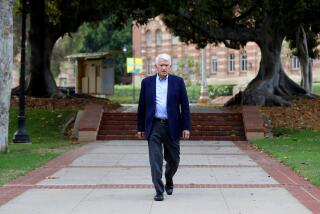Bill on Seismic Risk Disclosure Nears Passage
All it took was one map released by the state in December to send scores of Laguna Niguel residents into a panic about the resale value of their homes.
The map declared that half the city is a seismic hazard zone where thousands of houses are at risk of being swept away in landslides or sinking into the ground in a major earthquake--something the owners would have to disclose upon selling their houses.
For the record:
12:00 a.m. Aug. 15, 2002 For The Record
Los Angeles Times Thursday August 15, 2002 Home Edition Main News Part A Page 2 National Desk 15 inches; 536 words Type of Material: Correction
Seismic zones--A color map that ran in some editions of Wednesday’s California section incorrectly transposed liquefaction areas with landslide areas. A black-and-white version that ran in other editions was accurate. A corrected version appears on Page B3 in the editions that published the color map.
It’s a situation that’s playing out in cities all over Southern California as the state releases seismic hazard maps that show vast areas where such dangers may exist.
But Laguna Niguel officials argue that the maps are misleading since many of the hazards are based on records and aerial photos that are decades old. Hilltop grading, soil movement and the addition of structures that protect homes against the seismic shifts are not reflected in the maps, they say.
The city took their case to state lawmakers, who are now poised to pass a bill that would inform home buyers about how the risks have been dealt with and direct them to several places where they can learn about the potential dangers beneath properties.
The state Board of Realtors has thrown its considerable weight behind the bill, SB 1500.
The proposal seems simple enough. Yet mitigation often fails and critics of the bill say some of the places it would direct people to go to research property are likely to give them wrong information.
They say that the bill takes a disclosure process that is already filled with flaws and makes it even worse, heightening the risks for home buyers.
“All this bill does is muddy the waters,” said Sen. Sheila Kuehl (D-Santa Monica). “I don’t know what Laguna Niguel thinks they will gain from this, except perhaps the ability to say everything is fine.”
The state Department of Conservation has lobbied against the bill, and even shared photographs with state lawmakers of an area of Laguna Niguel that collapsed in a landslide years after mitigation efforts. They say the proposed disclosure changes direct home buyers to review complex state guidelines that have nothing to do with their particular development.
“The proposed changes in this bill are ... likely to create an unfortunate impression in the minds of home buyers,” wrote department director Darryl Young in a letter to state lawmakers, adding that the changes would “actually direct the home buyer further from the best source of information” available about risks on a property. Department officials say the only reliable source of information is a city planning office.
Others warn that even the local planning office is unreliable and say a complete overhaul of the seismic mapping program is needed to effectively warn home buyers of the risks they face.
Former State Geologist Jim Slosson says the mitigation records at city offices are of dubious value because the program relies on consultants hired by developers to certify that work has been done properly. Builders are free to disregard the opinions of experts they hire until they hear one they like, Slosson said.
“The loophole is big enough for an elephant to walk through,” he said.
Officials from Laguna Niguel defend their proposal as a way of giving home buyers as much information as possible.
“You don’t want buyers to categorically dismiss a property because it is in a landslide area when the reality is the landslide danger has long since been removed,” said Bob Lenard, the city’s community development director.
The city had initially lobbied the state to remove from seismic maps those areas where mitigation efforts are in place. Lenard and others presented state officials with detailed data showing what they said was successful mitigation in areas the state warned were at risk.
“A lot of areas are mapped as seismic hazards that shouldn’t be,” Lenard said.
The city’s proposal to change the maps was met with fierce opposition from Department of Conservation officials, who presented pictures of the landslide in Laguna Niguel to show that the process of removing seismic risks is far from fail-safe.
The bill was stripped of language calling for the maps to be changed, but opponents worry that passage in its current form will only give momentum to the push for those changes later.
“Proponents of this bill seem to be worried that people will be panicked about where the house they are buying is located,” Kuehl said. “If people are getting panicked, that may be because they are getting real information for the first time about where the house is located. The panic can be appropriate.”
More to Read
Start your day right
Sign up for Essential California for news, features and recommendations from the L.A. Times and beyond in your inbox six days a week.
You may occasionally receive promotional content from the Los Angeles Times.







